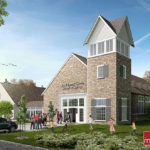EASTPOINTE, Mich. (BP)—“Shell shocked.” That’s how Michigan pastor Mathew Vroman felt after learning of the Nov. 5 massacre at a small Texas church that left 26 worshippers dead at the hands of a gunman.
So Vroman, pastor of Eastside Community Church in Eastpointe, Mich., joined the expanding cadre of small- and medium-sized-church leaders who are developing security plans in an effort to prevent armed attacks and other threats at their churches.
Before the Sutherland Springs shooting, Vroman said he knew he should develop a security plan.
“But I didn’t look at it as a priority,” he acknowledged.
After the church shooting, Vroman said, he was shocked into taking action.
“I don’t want to be a pastor that didn’t do all I could to try to protect my folks with a plan,” he said.
As a first step toward a fully orbed security plan, Eastside—which averages 60 to 100 in morning worship attendance—identified a man in the congregation to lead a security team. The church also has begun to station a volunteer security watchman at the door during worship services and started to secure the door in its children’s area.
In January, a team from Eastside will attend a church security training session sponsored by the Baptist State Convention of Michigan.
Sign up for our weekly edition and get all our headlines in your inbox on Thursdays
“We ultimately trust the Lord for everything,” Vroman said. “But we are not determinists, and we’re not fatalists. So we have to be proactive in not just shepherding by preaching the word (of God), but we also have to protect our people physically, give them a safe place to come.”
Security became ‘a pressing issue’
For John Mark Simmons, pastor of Highland Hills Baptist Church in Las Vegas, this fall brought two tragic reminders of the need for church security—Sutherland Springs and an Oct. 1 shooting at a country music festival on the Las Vegas Strip that killed 58 people and injured more than 500 others.
“For the last several years, I’ve been concerned about security at the church,” Simmons said. But “it wasn’t a pressing issue.”
Following the two shootings, however, a church member emailed Simmons expressing “a burden to move the church forward” regarding security, the pastor said.
In response, Highland Hills—which averages 250 in worship—has enlisted a volunteer security team of about 15 church members and held two meetings in its ongoing process to develop a security plan. The security team has been aided by instructional videos from its insurance company and may attend training sessions in the future.
Measures Highland Hills already has taken include locking doors that don’t need to be open during church events, stationing a “watchman of the day” at the main entrance on Sundays and installing security film on some windows to prevent an intruder from smashing them and entering.
Additionally, the team is educating the entire congregation about what to do in the event of various types of security threats. No one on the team is required to carry a gun, Simmons noted.
“I hope our attendees and worshippers will feel that we have been diligent and maybe have a bit more peace of mind that we are doing what we can to make the church a safe environment,” Simmons said, adding a security team can be an opportunity for otherwise uninvolved members to serve the church body.
Meet with law enforcement
Tarpley Baptist Church is located about 100 miles northeast of Sutherland Springs. The day after the Sutherland Springs attack, Tarpley pastor Dick Sisk met with two law enforcement officers in the congregation to hammer out a security plan “that was adapted to our particular situation,” he said.
Tarpley’s plan includes proactive measures to prevent crimes at the church, procedures to employ in the event of an active threat and protocol to follow after a security threat has passed.
During worship services—generally attended by 80 to 95 people—the congregation always has a marked law enforcement vehicle parked near the parking lot entrance, Sisk said. Two law enforcement officers in the church are armed and seated strategically in the auditorium. Greeters, workers in the sound booth and a team of security volunteers also have been assigned security duties.
Sisk commended church security training events but said small churches can take action even as they wait for the next convenient training event.
Pastors should “sit down with people in law enforcement, even if they go to another church,” he said.
Vroman, Simmons and Sisk all stressed church security is not reserved for megachurches with extensive resources.
Congregations of all sizes can “give … people a sense of security that somebody is alert and there is a plan in place,” Sisk said.













We seek to connect God’s story and God’s people around the world. To learn more about God’s story, click here.
Send comments and feedback to Eric Black, our editor. For comments to be published, please specify “letter to the editor.” Maximum length for publication is 300 words.